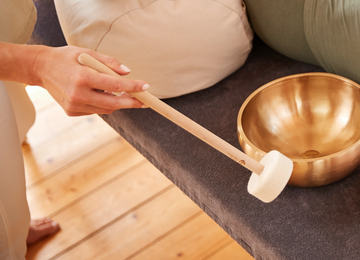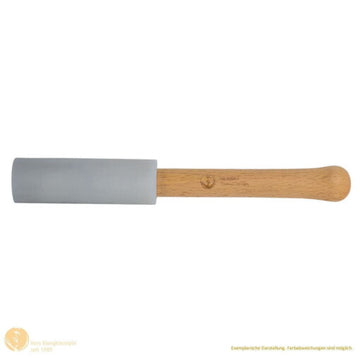
The most important facts in brief
- As the name suggests, gong friction mallets are used to rub a gong, whereas gong mallets are used to strike a gong.
- It is similar with Singing Bowls: a friction mallet is used to move along the edges of Singing Bowl, while a mallet is used to create sounds by gently tapping.
- However, the differences between friction mallets and mallets are not only in the playing technique, the models also vary in material and shape.
- For a Singing Bowl you generally use much smaller mallets than when playing a gong.
What is the difference between friction mallets and mallets?
If you have already taken a look at our range, you may know that - from a purely visual point of view - the difference between friction mallets and mallets (also known as mallets) is not always easy to recognize. In fact, they are not just two different instruments that are played and used very differently. The material and shape of a friction mallet also differ significantly from a mallet.
Let's start with the basics: a friction mallet is used to rub a gong or a Singing Bowl, a mallet is used to strike a gong or a Singing Bowl. Which sounds are produced depends on various points.
The strike of a gong or Singing Bowl can produce mainly deep, dark sounds, while rubbing gongs or Singing Bowls produces mainly bright tones, which also last much longer due to the constant rubbing. Depending on the zone in which you use the mallet or friction mallet on a gong, for example, different sounds and volumes are also produced. For example, the tones are significantly brighter at the edge of a gong than in its center.

Note
The main difference between friction mallets and mallets is that they are used differently. While the friction mallets is used to rub the gong or Singing Bowl , the mallet is used for gentle or intensive strokes that produce the very characteristic tones
How do gong drivers differ from singing bowl drivers?
Gong mallets and singing bowl mallets differ only slightly from each other. Gong mallets are usually slightly longer than singing bowl mallets, as the surface area to be played on a gong is also significantly larger than on a traditional Singing Bowl. In terms of material, the friction mallets differs to some extent from singing bowl mallets: While the friction mallets usually have a very soft rubber or caoutchouc head, singing bowl mallets also have aluminum heads or - in the form of a rubbing mallet - are even made entirely of wood. A rubbing mallet produces a very targeted and distinctive sound on a Singing Bowl , which would not be possible on a gong.
There are also special features with classic gong pens: There are also two-sided gong pens, which are equipped with a caoutchouc head in different sizes at both ends of the handle. the friction mallet can be used on both sides and therefore offers a wider range of tones.
There are also graters that are suitable for playing the gong as well as for producing sound with Singing Bowls . These include, for example, the ollihess rubbers from the Lava Edition, whose head is made of natural rubber and is available in four different sizes. Depending on the sound instrument used, you can produce a wide variety of tones and vibrations with these rubbers.
What is the difference between singing bowl mallets and gong mallets?
A Singing Bowl is generally much more compact and smaller than a classic gong. Even though similar materials and shapes are usually used for both variants, significantly smaller mallets are used to produce the sound on the Singing Bowl than when playing a gong. This also makes sense for purely practical reasons - because a significantly greater force is required to produce a sound by striking the gong. The longer the mallet handle, the more effectively the mallet can be used.
In our store you will find a whole range of different mallets especially for Singing Bowls - for example felt mallets with a soft felt head, slightly harder rubber mallets with a natural rubber head or metallic aluminum mallets that are particularly easy to disinfect.

Note
Longer mallets are ideal for gongs, while smaller and therefore lighter mallets are used for Singing Bowls .
How are gong drivers and singing bowl drivers used?
Anyone looking at the differences between mallets and reeds must first and foremost take a look at the way they are played. Of course, there are also differences between using them on a gong or on a Singing Bowl - because a gong is used completely differently to a Singing Bowl.
Playing technique with a friction mallet
You have to rub a gong driver over the gong to produce a beautiful and long-lasting sound. The entire surface of the gong is available to you for this. The tones produced at the edge of the gong are very different from the tones that can be produced in the center of the gong. However, it is not only the different sizes the friction mallet and the positioning of the instrument that make up an important part of the sound, but also the material and shape of the grater used - and of course the gong itself. There are different types of gong, which can have very different sound spectra.

Playing technique with a singing bowl recorder
The Singing Bowl is primarily designed for strike with mallets. If you would like to produce the characteristic tones with a singing bowl friction mallet, you do not have the entire Singing Bowl at your disposal. To make the bowl vibrate, run the friction mallet along the outside edge of the Singing Bowl and trigger the vibrations that also produce the sounds. Exciting to observe: The longer you rub, the stronger and more persistent the sound becomes!

How are gong mallets and singing bowl mallets used?
Various factors play a role in sound production with a mallet. The intensity and character of the sound produced by a Singing Bowl depends on the type of mallet, the way it is played and the shape of the Singing Bowl . With the gong, it depends not only on the playing style and type of gong but also on the positioning in the room. We have summarized the striking techniques for you:
Gong strike with a gong mallet
The gong mallet should always be in proportion to the size of your gong. How you play the gong always depends on which tones you want to produce. The lowest notes and fundamental tones are produced in the center of the gong. In direct contrast to this is the edge of the gong, where you can reach the highest possible frequency ranges. Between these two areas, the remaining surface of the gong offers you a varied sound spectrum. You can find more information in our article on playing the gong.
Singing Bowl strike with a singing bowl mallet
Playing a Singing Bowl with a mallet requires significantly less force than playing a gong. To produce an intense sound, strike the outside of the Singing Bowl gently with the singing bowl mallet. The closer you strike the bottom of the Singing Bowl , the stronger the sound will be. You should also make sure that you hit as large an area as possible when striking the strike of the Singing Bowl . So make sure that your mallet hits the outside of the Singing Bowl as straight as possible.
How you can use the differences between friction mallets and mallets
The fact that reeds and mallets are used so differently brings you numerous advantages. If you already have a Singing Bowl or a gong, you can create fundamentally different tones and sounds with friction mallets and mallets. The different playing techniques always have surprises in store for you. Test your skills with friction mallets and mallets alike to immerse yourself in the world of sounds and develop a feel for the individual characteristics of the instruments. This way, you can get the most out of your instrument and make full use of your creativity.






